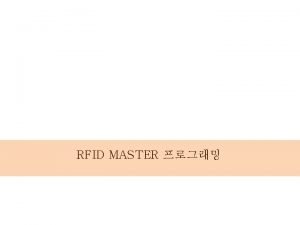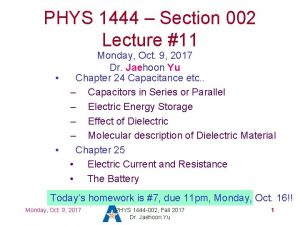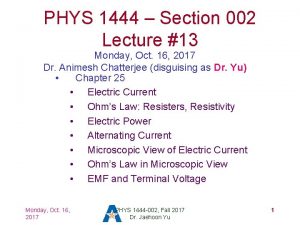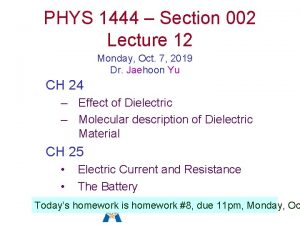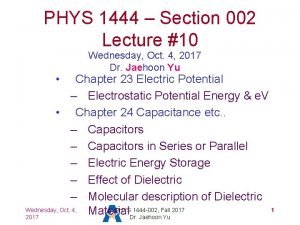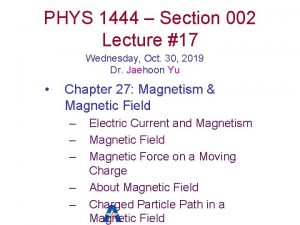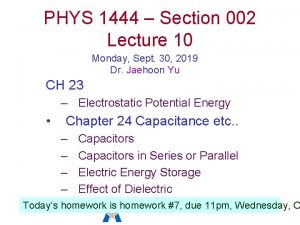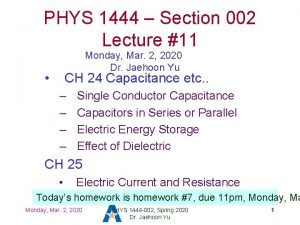PHYS 1444 Section 002 Lecture 9 Monday Oct









- Slides: 9

PHYS 1444 – Section 002 Lecture #9 • Monday, Oct. 2, 2017 Dr. Jaehoon Yu Chapter 23 Electric Potential – V due to Charge Distributions – Equi-potential Lines and Surfaces – Electric Potential Due to Electric Dipole – Electrostatic Potential Energy • Chapter 24 Capacitance etc. . Capacitors Today’s–homework is homework #6, due 11 pm, Monday, Oct. 9!! PHYS 1444 -002, Fall 2017 Monday, Oct. 2, 2017 Dr. Jaehoon Yu 1

Announcements • Bring out your special project #3 now • Special colloquium 4 pm tomorrow, Tuesday, Oct. 3 in SH 103 – Dr. Joseph Ngai of UTA Physics dept. Monday, Oct. 2, 2017 PHYS 1444 -002, Fall 2017 Dr. Jaehoon Yu 2


• Electric Potential by Charge Distributions Let’s consider a case of n individual point charges in a given space and V=0 at r=∞. • Then the potential Via due to the charge Qi at point a, distance ria from Qi is • Thus the total potential Va by all n point charges is • For a continuous charge distribution, Monday, Oct. 2, 2017 PHYS 1444 -002, Fall 2017 we obtain Dr. Jaehoon Yu 4

Example • Potential due to two charges: Calculate the electric potential (a) at point A in the figure due to the two shown, isand (b) at • charges Electric potential a scalar point B. so one adds the potential quantity, by each of the source charge, as if they are numbers. (a) potential at A is (b) How about potential at B? Oct. 2, 2017 Monday, PHYS 1444 -002, Fall 2017 Dr. Jaehoon Yu 5

Example 23 – 8 • Potential due to a ring of charge: A thin circular ring of radius R carries a uniformly distributed charge Q. Determine the electric potential at a point P on the axis of the ring a distance x from its center. • Each point on the ring is at the same distance from the point P. What is the distance? • So the potential at P is What’s this? Monday, Oct. 2, 2017 PHYS 1444 -002, Fall 2017 Dr. Jaehoon Yu 6

Equi-potential Surfaces • Electric potential can be graphically shown using the equipotential lines in 2 -D or the equipotential surfaces in 3 -D • Any two points on the equipotential surfaces (lines) are at the same potential • What does this mean in terms of the potential difference? – The potential difference between the two points on an equipotential surface is 0. • How about the potential energy difference? – Also 0. • What does this mean in terms of the work to move Oct. 2, 2017 1444 -002, Fall 2017 7 a. Monday, charge along the. PHYS surface between these two Dr. Jaehoon Yu

Equi-potential Surfaces • An equipotential surface (line) must be perpendicular to the electric field. Why? – If there any parallel components to the electric field, it would require work to move a charge along the surface. • Since the equipotential surface (line) is perpendicular to the electric field, we can draw these surfaces or lines easily. • Since there can be no electric field within a conductor in a static case, the entire volume of a conductor must be at the same potential. • So the electric. Point field must be perpendicular to the conductor Parall Just like the topological surface. charg el map es Plate Monday, Oct. 2, 2017 PHYS 1444 -002, Fall 2017 Dr. Jaehoon Yu 8

Electric Potential due to Electric Dipoles • What is an electric dipole? – Two equal point charge Q of opposite signs separated by a distance l and behaves like one entity: P=Ql • For the electric potential due to a dipole at a point p – We take V=0 at r=∞ • The simple sum of the potential at p by the two charges is V by a dipole at a distance r from PHYS 1444 -002, Fall 2017 Dr. Jaehoon Yu the dipole • Monday, Since Δr=lcosθ and if r>>l, r>>Δr, then Oct. 2, 2017 r~r+Δr and 9



